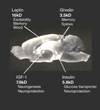60 YEARS OF NEUROENDOCRINOLOGY: Redefining neuroendocrinology: stress, sex and cognitive and emotional regulation
- PMID: 25934706
- PMCID: PMC4515381
- DOI: 10.1530/JOE-15-0121
60 YEARS OF NEUROENDOCRINOLOGY: Redefining neuroendocrinology: stress, sex and cognitive and emotional regulation
Abstract
The discovery of steroid hormone receptors in brain regions that mediate every aspect of brain function has broadened the definition of 'neuroendocrinology' to include the reciprocal communication between the brain and the body via hormonal and neural pathways. The brain is the central organ of stress and adaptation to stress because it perceives and determines what is threatening, as well as the behavioral and physiological responses to the stressor. The adult and developing brain possess remarkable structural and functional plasticity in response to stress, including neuronal replacement, dendritic remodeling, and synapse turnover. Stress causes an imbalance of neural circuitry subserving cognition, decision-making, anxiety and mood that can alter expression of those behaviors and behavioral states. This imbalance, in turn, affects systemic physiology via neuroendocrine, autonomic, immune and metabolic mediators. In the short term, as for increased fearful vigilance and anxiety in a threatening environment, these changes may be adaptive. But, if the danger passes and the behavioral state persists along with the changes in neural circuitry, such maladaptation may need intervention with a combination of pharmacological and behavioral therapies, as is the case for chronic anxiety and depression. There are important sex differences in the brain responses to stressors that are in urgent need of further exploration. Moreover, adverse early-life experience, interacting with alleles of certain genes, produce lasting effects on brain and body over the life-course via epigenetic mechanisms. While prevention is most important, the plasticity of the brain gives hope for therapies that take into consideration brain-body interactions.
Keywords: behaviour; brain; hormone action; neuroendocrinology; stress hormones.
© 2015 Society for Endocrinology.
Figures










References
-
- Acheson SD. Independent Inquiry into Inequalities in Health Report. London: The Stationary Office; 1998.
-
- Ahima R, Krozowski Z, Harlan R. Type I corticosteroid receptor-like immunoreactivity in the rat CNS: distribution and regulation by corticosteroids. J.Comp.Neurol. 1991;313:522–538. - PubMed
-
- Ahima RS, Harlan RE. Charting of type II glucocorticoid receptor-like immunoreactivity in the rat central nervous system. Neuroscience. 1990;39:579–604. - PubMed
-
- Altman J. Are new neurons formed in the brains of adult mammals? Science. 1962;135:1127–1128. - PubMed
Publication types
MeSH terms
Substances
Grants and funding
LinkOut - more resources
Full Text Sources
Medical
Research Materials

